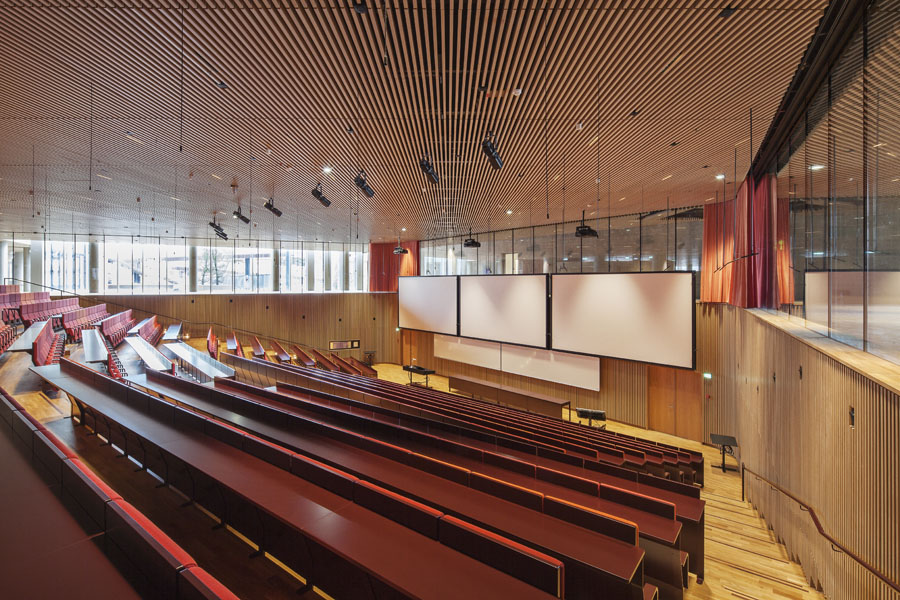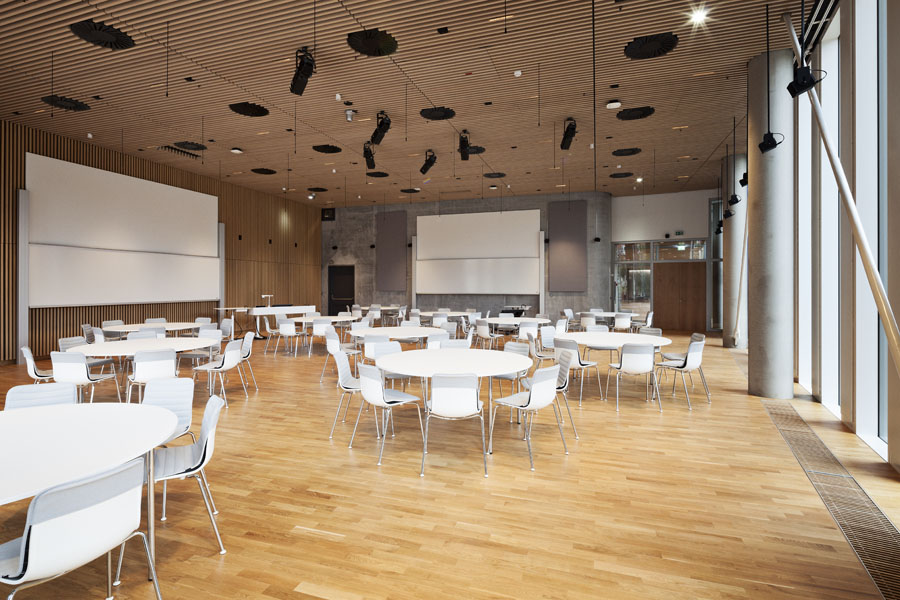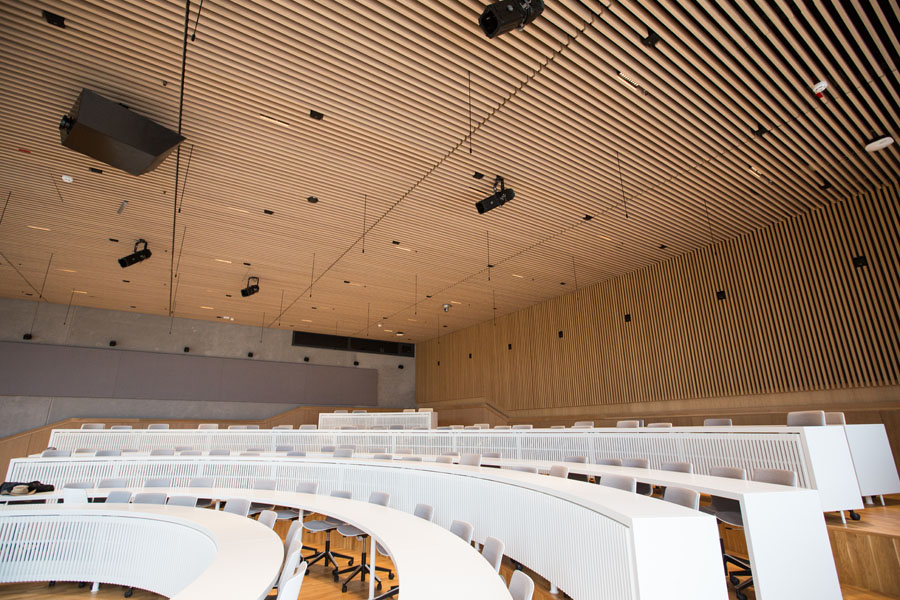
With the installation of Constellation acoustic system by Meyer Sound, Copenhagen’s new Maersk Building demonstrates a major commitment to world-class dynamic and collaborative 21st century learning. Located at the Panum Institute’s Faculty of Health and Medical Sciences on the North Campus of the University of Copenhagen, the striking new Maersk Tower showcases Constellation in three distinct auditoriums.
With more than 300 loudspeakers in three venues, the Maersk Tower boasts by far the largest education-focused Constellation installation in the world, signaling an important step forward in the use of sophisticated acoustic technology in support of modern research and teaching.
All AV systems at the site were designed, engineered and installed by Stouenborg ApS of Copenhagen under the supervision of project leader Anders Jorgensen.
« The A.P. Møller Foundation’s commitment to offering the most advanced acoustic solution to the Faculty of Health and Medical Sciences was critical to the success of the project,” says Jorgensen. “Indeed, all principal parties involved in the project agreed that Constellation would be a catalyst for deeper and more collaborative learning experiences. By applying the most advanced audio technology, we are able to offer the ultimate flexibility for each room.
Different acoustic settings can be customized to synchronize with the presentation, whether that is a lecture format, Q and A, discussion, or even a musical performance. With Constellation, there is no need for radio mics, eliminating the separation between teacher and learner and allowing free and perfectly intelligible communication even in an audience of 504 seats. The possibilities are endless in terms of collaboration and new dimensions in learning. »

Sought-after qualities
« We expect that the Constellation systems, in conjunction with other state-of-the-art AV technologies within the auditoria, will introduce the highest possible quality of sound,” remarks Pernille Illum, project consultant with the A.P. Möller Foundation. “This will drive further developments in teaching and communication, benefiting students as well as international conferences. We expect these auditoria to become widely known and sought-after for these unique qualities. »
In the Maersk Tower auditoriums, the Constellation systems tailor the acoustic characteristics of the space with the touch of a button. In presentation mode, Constellation carries the voice of a lecturer throughout the room without need of a podium or headset microphone. In Q&A mode, both lecturer and students can hear each other without passing around handheld microphones. In one auditorium with flexible seating (including tables as needed), a group discussion mode allows students around a table to hear each other clearly while masking distracting conversations from adjoining groups. Ideal acoustics can also be created for special evenings featuring musical or theatrical performances.
Constellation creates flexible acoustics using multiple distributed microphones, placed throughout the space, which feed signals to a powerful D-Mitri digital audio platform for processing by the patented VRAS (Variable Room Acoustic System) algorithms. The acoustical signature of the room, as determined by the chosen preset, is generated by dozens of small, self-powered loudspeakers placed discreetly overhead and around the walls.

Three Constellation, one CAL
The equipment complement required by Constellation is proportional to room size. The largest auditorium, seating 550, deploys a total of 89 microphones, 124 loudspeakers and 19 networked D-Mitri frames, including core processing, D-VRAS and input/output. The other two auditoriums, seating 220 and 120, have systems with 32 microphones and 97 loudspeakers; and 32 microphones with 88 loudspeakers.
In addition to the ultra-compact MM-4XP and MM-4XPD self-powered loudspeakers, the systems also include MM-10XP subwoofers for full bandwidth reproduction. Presets with extended reverberation envelopes allow use of Constellation to create completely natural acoustical environments for musical performances, a possible alternate use for the auditoriums on special occasions.
A fourth, 120-seat space, features two CAL 32 self-powered steerable column array loudspeakers, widely hailed as a quantum leap forward in steerable array technology that offers an unprecedented level of accuracy both in its sonic quality and directionality. CAL is another example of unique solutions that develop from a Meyer Sound culture that is also dedicated to research and the application of science-based solutions to some of the most difficult problems confronting audio professionals. The last 20 Stella 8C ceiling loudspeakers and four MM-10XPs are spread out on two conference halls and a lecture hall at the top level at the 15th floor. Here, listeners can enjoy not only the sonic precision of Stella 8C ceiling loudspeakers but also the incredible view over Copenhagen.

The Maersk building’s full AV infrastructure required installation of more than 22 km of cable, most of it Cat6a to support current and future networked applications. Both the Meyer Sound D-Mitri and Biamp Systems Tesira (used for auxiliary systems and smaller rooms) platforms share the common AVB open-source networking protocols. Other key equipment specified by Stouenborg includes Panasonic video screens and projectors, a 4k-capable Crestron Digital Media System, Onelan media players, and Smart Graphics computer interfaces.
Throughout the project, Stouenborg qualified and evaluated competing products to ensure that each installed component not only incorporated the latest technology but also provided the highest overall quality and was best suited to the task. This was certainly the case with the active acoustics system. “There is no other solution in the world that comes close to Constellation,” says Stouenborg’s project leader, Anders Jorgensen.
Opened in January 2017, the Maersk Tower expands the total floor space of the Panum Institute by 40 percent and houses some of the world’s most advanced facilities for medical education and research. The building’s name reflects funding and planning support from the A.P. Møller Foundation which was established by Mr. A.P Møller, who founded the Maersk Group with his father, Captain Peter Maersk Møller.







